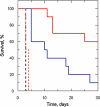Trypanosoma brucei pteridine reductase 1 is essential for survival in vitro and for virulence in mice
- PMID: 20545846
- PMCID: PMC2916222
- DOI: 10.1111/j.1365-2958.2010.07236.x
Trypanosoma brucei pteridine reductase 1 is essential for survival in vitro and for virulence in mice
Abstract
Gene knockout and knockdown methods were used to examine essentiality of pteridine reductase (PTR1) in pterin metabolism in the African trypanosome. Attempts to generate PTR1 null mutants in bloodstream form Trypanosoma brucei proved unsuccessful; despite integration of drug selectable markers at the target locus, the gene for PTR1 was either retained at the same locus or elsewhere in the genome. However, RNA interference (RNAi) resulted in complete knockdown of endogenous protein after 48 h, followed by cell death after 4 days. This lethal phenotype was reversed by expression of enzymatically active Leishmania major PTR1 in RNAi lines ((oe)RNAi) or by addition of tetrahydrobiopterin to cultures. Loss of PTR1 was associated with gross morphological changes due to a defect in cytokinesis, resulting in cells with multiple nuclei and kinetoplasts, as well as multiple detached flagella. Electron microscopy also revealed increased numbers of glycosomes, while immunofluorescence microscopy showed increased and more diffuse staining for glycosomal matrix enzymes, indicative of mis-localisation to the cytosol. Mis-localisation was confirmed by digitonin fractionation experiments. RNAi cell lines were markedly less virulent than wild-type parasites in mice and virulence was restored in the (oe)RNAi line. Thus, PTR1 may be a drug target for human African trypanosomiasis.
Figures










Similar articles
-
Dissecting the metabolic roles of pteridine reductase 1 in Trypanosoma brucei and Leishmania major.J Biol Chem. 2011 Mar 25;286(12):10429-38. doi: 10.1074/jbc.M110.209593. Epub 2011 Jan 14. J Biol Chem. 2011. PMID: 21239486 Free PMC article.
-
Chemical and genetic validation of dihydrofolate reductase-thymidylate synthase as a drug target in African trypanosomes.Mol Microbiol. 2008 Jul;69(2):520-33. doi: 10.1111/j.1365-2958.2008.06305.x. Mol Microbiol. 2008. PMID: 18557814 Free PMC article.
-
Trypanosoma brucei brucei oligopeptidase B null mutants display increased prolyl oligopeptidase-like activity.Mol Biochem Parasitol. 2012 Mar-Apr;182(1-2):7-16. doi: 10.1016/j.molbiopara.2011.11.007. Epub 2011 Nov 22. Mol Biochem Parasitol. 2012. PMID: 22123425
-
In or out? On the tightness of glycosomal compartmentalization of metabolites and enzymes in Trypanosoma brucei.Mol Biochem Parasitol. 2014 Nov;198(1):18-28. doi: 10.1016/j.molbiopara.2014.11.004. Epub 2014 Dec 2. Mol Biochem Parasitol. 2014. PMID: 25476771 Review.
-
Regulation of antigen gene expression in Trypanosoma brucei.Trends Parasitol. 2005 Nov;21(11):517-20. doi: 10.1016/j.pt.2005.08.016. Epub 2005 Aug 29. Trends Parasitol. 2005. PMID: 16126458 Review.
Cited by
-
Dissecting the metabolic roles of pteridine reductase 1 in Trypanosoma brucei and Leishmania major.J Biol Chem. 2011 Mar 25;286(12):10429-38. doi: 10.1074/jbc.M110.209593. Epub 2011 Jan 14. J Biol Chem. 2011. PMID: 21239486 Free PMC article.
-
Future Prospects in the Treatment of Parasitic Diseases: 2-Amino-1,3,4-Thiadiazoles in Leishmaniasis.Molecules. 2019 Apr 19;24(8):1557. doi: 10.3390/molecules24081557. Molecules. 2019. PMID: 31010226 Free PMC article. Review.
-
The Role of Folate Transport in Antifolate Drug Action in Trypanosoma brucei.J Biol Chem. 2016 Nov 18;291(47):24768-24778. doi: 10.1074/jbc.M116.750422. Epub 2016 Oct 4. J Biol Chem. 2016. PMID: 27703008 Free PMC article.
-
An essential thioredoxin-type protein of Trypanosoma brucei acts as redox-regulated mitochondrial chaperone.PLoS Pathog. 2019 Sep 26;15(9):e1008065. doi: 10.1371/journal.ppat.1008065. eCollection 2019 Sep. PLoS Pathog. 2019. PMID: 31557263 Free PMC article.
-
Chroman-4-One Derivatives Targeting Pteridine Reductase 1 and Showing Anti-Parasitic Activity.Molecules. 2017 Mar 8;22(3):426. doi: 10.3390/molecules22030426. Molecules. 2017. PMID: 28282886 Free PMC article.
References
-
- Alibu VP, Storm L, Haile S, Clayton C, Horn D. A doubly inducible system for RNA interference and rapid RNAi plasmid construction in Trypanosoma brucei. Mol Biochem Parasitol. 2005;139:75–82. - PubMed
-
- Banerjee SK, Kessler PS, Saveria T, Parsons M. Identification of trypanosomatid PEX19: functional characterization reveals impact on cell growth and glycosome size and number. Mol Biochem Parasitol. 2005;142:47–55. - PubMed
-
- Berriman M, Ghedin E, Hertz-Fowler C, Blandin G, Renauld H, Bartholomeu DC, et al. The Genome of the African Trypanosome Trypanosoma brucei. Science. 2005;309:416–422. - PubMed
Publication types
MeSH terms
Substances
Grants and funding
LinkOut - more resources
Full Text Sources
Other Literature Sources
Molecular Biology Databases

